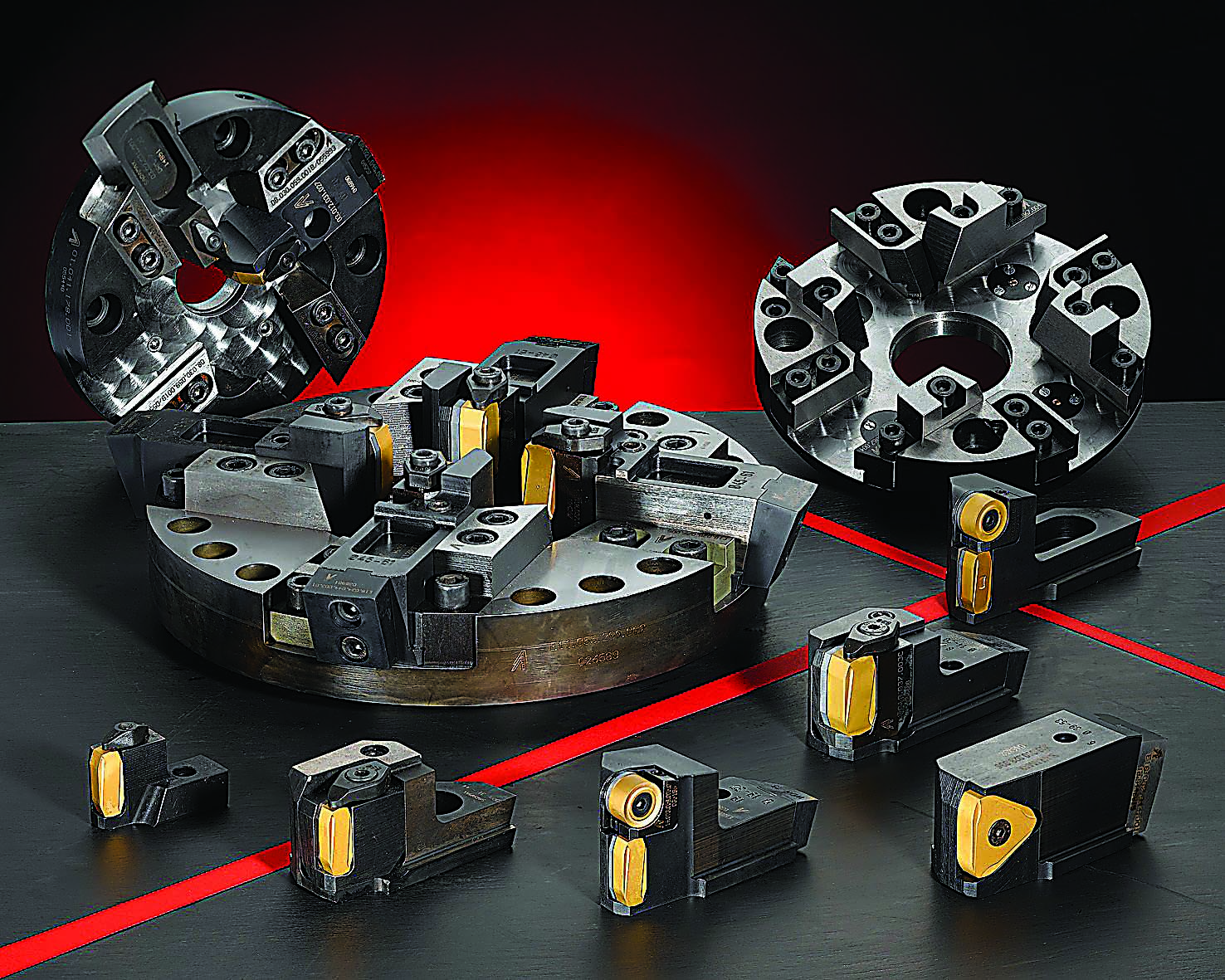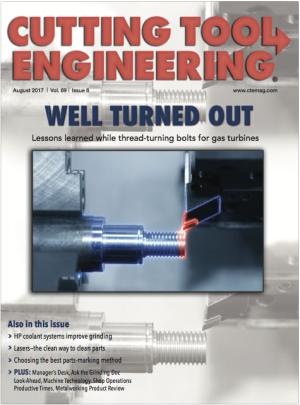If you’ve ever watched a bar of red-hot metal emerge from the furnace at a rolling mill, you might wonder how that scaly chunk of material became the smooth, shiny and accurate length of steel you just loaded into a lathe’s bar feeder. Machinists know it as cold-finished bar stock. For those who have turned a piece of ugly, dirty, hot-rolled 1018 or 4140 steel, they’re glad to have it. It got that way thanks to a process known as bar peeling.
Iwan Antonow, executive vice president of toolmaker Saar-Hartmetall USA LLC, Covington, Ky., said bar peeling is a post-rolling mill process. It removes scale, brings the bar to size and greatly improves its surface finish. The process, which works much like an apple peeler, is performed by a doughnut-shaped device equipped with four to six carbide-tipped cutting tools. These spin around and along the cut bar or coil of wire at speeds “substantially faster than is possible with turning,” he said.

Bar-peeling heads must be carefully adjusted so each insert cuts an equal amount of material as the bar passes. Image courtesy of Saar-Hartmetall USA.
Antonow explained that the speed is determined not so much by the number of cutters but by the material grade, the rpm of the cutter head and how quickly the bar travels through the peeling head. Those values are, in turn, determined by surface-quality requirements, how long the user wants the inserts to last and the amount of material being peeled off.
“Sometimes you shave the surface just enough to clean it up,” Antonow said, “and sometimes you remove substantial amounts of material because you want to bring it to a different diameter. Every application is different, and that’s what ultimately determines the speed. Regardless, it’s always faster than turning.”
The speed is augmented by the fact that bar peeling is often a continuous process. So-called coil-to-coil processing unwinds bar stock from one coil, feeds it through the bar peeler and winds it onto a coil at the opposite end of the processing line. It is used on wire from 5mm (0.197") up to about 12mm (0.472"), which—depending on the material—is the upper limit for coil stock.
According to Antonow, wire smaller than this is usually fed through extrusion dies, while larger stock (bars up to 18", or 457.2mm, in diameter are possible with bar peeling) is cut into standard 12' or 20' (3.66m or 6.10m) lengths before processing.
Saar-Hartmetall supplies the peeling heads, cartridges and inserts to bar-peeling machine builders as original equipment and adapts its tooling to other brands of peeling machines. The company also provides aftermarket tools to end users.
Bar-peeling machines are often part of a “bright bar” line at a steel mill. Together with supporting processes such as straightening, grinding and burnishing, these machines convert hot-rolled steel, stainless steel and aerospace-grade alloy “black bar” into shiny and smooth-peeled bars.
Related Glossary Terms
- burnishing
burnishing
Finishing method by means of compressing or cold-working the workpiece surface with carbide rollers called burnishing rolls or burnishers.
- extrusion
extrusion
Conversion of an ingot or billet into lengths of uniform cross section by forcing metal to flow plastically through a die orifice.
- grinding
grinding
Machining operation in which material is removed from the workpiece by a powered abrasive wheel, stone, belt, paste, sheet, compound, slurry, etc. Takes various forms: surface grinding (creates flat and/or squared surfaces); cylindrical grinding (for external cylindrical and tapered shapes, fillets, undercuts, etc.); centerless grinding; chamfering; thread and form grinding; tool and cutter grinding; offhand grinding; lapping and polishing (grinding with extremely fine grits to create ultrasmooth surfaces); honing; and disc grinding.
- milling machine ( mill)
milling machine ( mill)
Runs endmills and arbor-mounted milling cutters. Features include a head with a spindle that drives the cutters; a column, knee and table that provide motion in the three Cartesian axes; and a base that supports the components and houses the cutting-fluid pump and reservoir. The work is mounted on the table and fed into the rotating cutter or endmill to accomplish the milling steps; vertical milling machines also feed endmills into the work by means of a spindle-mounted quill. Models range from small manual machines to big bed-type and duplex mills. All take one of three basic forms: vertical, horizontal or convertible horizontal/vertical. Vertical machines may be knee-type (the table is mounted on a knee that can be elevated) or bed-type (the table is securely supported and only moves horizontally). In general, horizontal machines are bigger and more powerful, while vertical machines are lighter but more versatile and easier to set up and operate.
- turning
turning
Workpiece is held in a chuck, mounted on a face plate or secured between centers and rotated while a cutting tool, normally a single-point tool, is fed into it along its periphery or across its end or face. Takes the form of straight turning (cutting along the periphery of the workpiece); taper turning (creating a taper); step turning (turning different-size diameters on the same work); chamfering (beveling an edge or shoulder); facing (cutting on an end); turning threads (usually external but can be internal); roughing (high-volume metal removal); and finishing (final light cuts). Performed on lathes, turning centers, chucking machines, automatic screw machines and similar machines.


